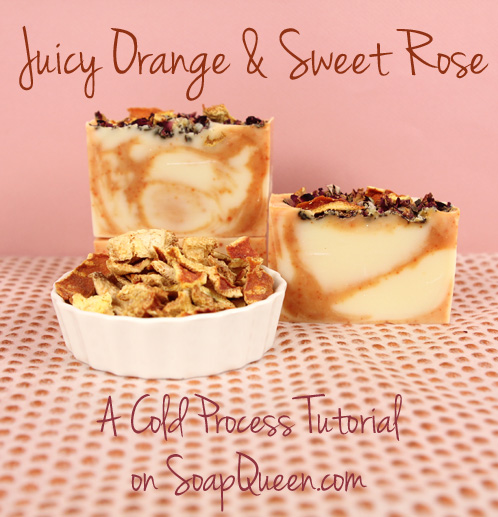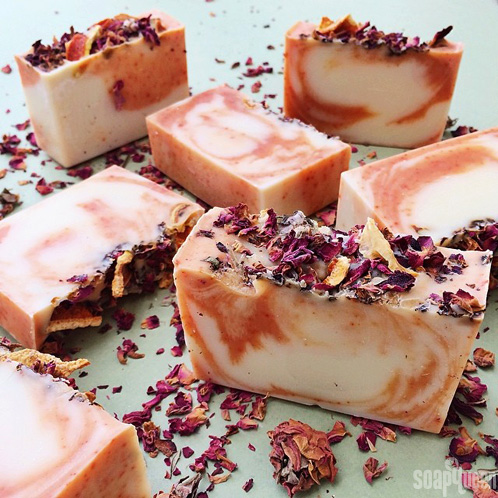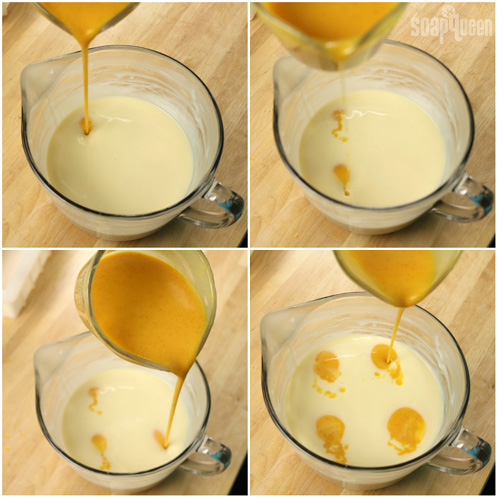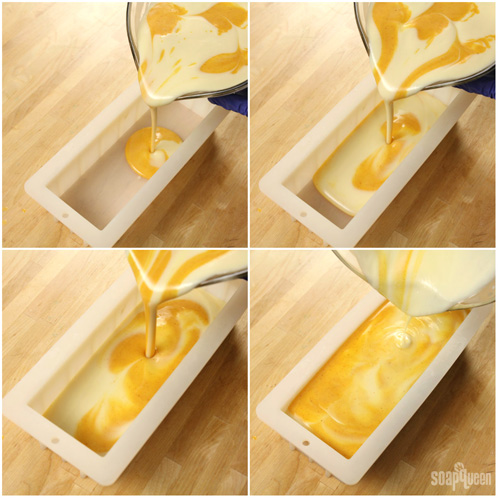
What You’ll Need:
9.9 oz. Coconut Oil
9.9 oz. Olive Oil
9.9 oz. Palm Oil
3.3 oz. Rice Bran Oil
4.6 oz. Sodium Hydroxide
10.8 oz. distilled water
1 oz. 10x Orange Essential Oil
If you’ve never made Cold Process soap before, check out our FREE four part SoapQueen.tv series on Cold Process Soapmaking, especially the episode on lye safety. Bramble Berry also carries a wide range of books on the topic, including Soap Crafting. You can also checkout the digital downloads.
SAFETY FIRST: Suit up for safety! That includes goggles, gloves and long sleeves. Make sure kids, pets, and other distractions and tripping hazards are out of the house or don’t have access to your soaping space. Always soap in a well-ventilated area.

COLOR PREP: To make sure the Titanium Dioxide blends smoothly into the soap, we recommend micronizing it beforehand. This is an optional step, but it does help prevent the Titanium Dioxide from clumping. To micronize the colorant, use a coffee grinder to blend the colorant to break up any clumps of color and prevent streaks of white from showing in the final soap. Then, disperse 1 teaspoon of the colorant into 1 tablespoon of sunflower or sweet almond oil (or any other liquid oil). Then, disperse 1 teaspoon of paprika into 1 tablespoon of a light liquid oil. Use a mini mixer to incorporate.
NOTE ABOUT THE TOPPING: Although the rose petals and orange peel make for a beautiful top for your soap, they will mold if left in a moist environment, like your shower. They are just for decoration. Like any natural material, they will wilt and eventually fall off, and there isn’t a way to preserve them. If you plan on making this soap and selling it, that’s something you’ll want to tell your customers! You can tell them to pick off the herbs on the top, or they’ll naturally fall off after a few washings anyway.
ONE: Slowly and carefully add the lye to the water and stir carefully until the lye has fully dissolved and the liquid is fully clear. Set aside to cool.
TWO: Mix the coconut, olive oil, rice bran and palm oils (remember to fully melt and mix your entire container of palm oil). Once the lye water and the oils have cooled down to 130 degrees or below (and are within 10 degrees of each other ideally), add the lye water to the oils and stick blend until thin trace. If you’d like a firmer bar of soap that releases faster from your mold, you can add sodium lactate to the cooled lye water mixture. Use 1 teaspoon of sodium lactate per pound of oils in your recipe. For this soap, you’d add about 2 tsp. sodium lactate total.


THREE: Once your soap is at a light trace, pour about 2 cups of the batter into a second container.

FOUR: Next, add 3 tsp. of dispersed Titanium Dioxide to the original container and 3 tsp. dispersed paprika to the second container. Whisk the colorant in well.

FIVE: The 10x Orange Essential Oil will color soap a bright orange color, so add it only to the paprika batter. Mix the essential oil in with a whisk. Citrus essential oils tend to break up your trace, so make sure to stir well.

SIX: For the in-the-pot swirl design, pour the orange soap into the white soap in 4 places: 12:00 o’clock, 4:00 o’clock, 8:00 o’clock, and the center. Pour the soap from a high point so it penetrates to the bottom of the soap, which will create a swirl the whole way through.

SEVEN: Using a chopstick, run the tool through each of the entry points once. Only swirl once so the colors don’t mix together.

EIGHT: Pour the soap into your mold. Keep the pouring container in one place, then tamp the mold on the tabletop to pop any air bubbles.

NINE: Sprinkle the rose petals and orange peels on top of the soap.


TEN: After 3-4 days, unmold the soap and allow it to cure for 4-6 weeks. When you cut the soap, turn it on its side to avoid pulling the petals or orange peels through. Enjoy!

